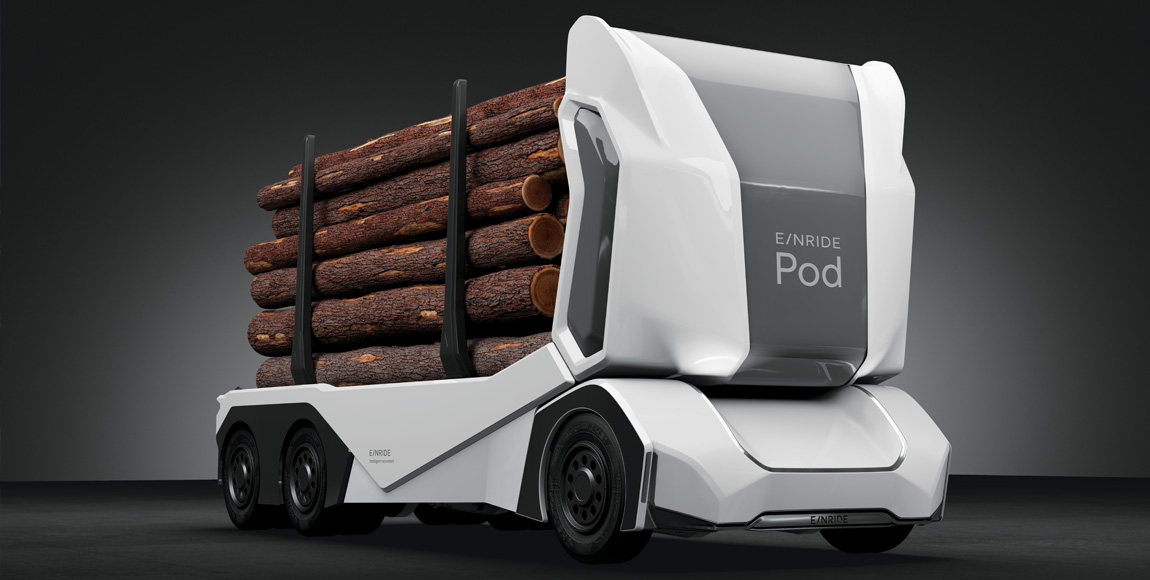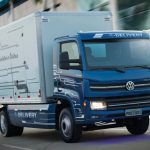Logging into the future

The time of autonomous vehicles is nigh with newsfeeds on these self-driving machines increasing each year. We discover that the forestry industry is also jumping on this bandwagon
History was made last year when the first cab-less electric truck – Einride’s autonomous truck, called the T-pod – drove on a public road, as was reported by Charleen Clarke, editorial director of FOCUS, in Issue 7, 2019.
“The ground-breaking event took place at DB Schenker’s facility in Jönköping, Sweden,” she wrote. “The T-pod will be used to transport goods between a warehouse and terminal at the facility.”
This came about after the Swedish Transport Agency issued the companies with a permit allowing the T-pod to drive on a public road (within an industrial area) between a warehouse and a terminal. The permit is valid until December 31, 2020.
The 26-t truck has a top speed of 85 km/h and a 200-km range. It is powered by a 200 kWh battery. “While it operates without a driver, it can be supervised and remotely operated by a human being. That person can be hundreds of kilometres away,” Clarke pointed out.

Einride’s plans include more than the road-freight industry. It has developed a concept vehicle
that incorporates some off-road capabilities and is designed to navigate forest roads while transporting timber.
Robert Falck, CEO of Einride, points out: “Einride is constantly pushing the boundaries of autonomous and all-electric vehicles in our ambition to lead the transition to a sustainable transportation system. With the Einride timber pod, we’ve created a vehicle that can withstand the rigours of a demanding environment.”
The timber pod, like its road-freight counterpart, has no driver’s cab – making it smaller and lighter. This, in turn, provides an increased loading capacity, lower production and operating costs and optimised energy consumption, allowing the Einride timber pod to run solely on its batteries – even in difficult environments.
Falck adds: “The driver’s cab is what makes trucks expensive to produce, and having a driver in the cabin is what makes them expensive to operate. Remove the cabin and replace the driver with an operator, who can remotely monitor and control several vehicles at once, and costs can be reduced significantly. In addition, operating a vehicle from a distance allows for a much better working environment, as has already been demonstrated in industries such as mining.”
Einride hopes to introduce the timber pod to public roads during this year, as several major global companies have expressed interest in it.
Einride isn’t the only company taking the autonomous route, as Svenska Cellulosa AB (SCA) – a Swedish timber, pulp and paper manufacturer – is participating in a comprehensive project to develop autonomous forestry machines.
Dubbed the Auto2 project, the Swedish forestry industry (including parties from universities, IT companies, forestry machinery manufacturers and forest management companies) wants to develop autonomous forwarders – the machines that carry the harvested timber to the forest road.
Running from December 2018 until the end of this year, Auto2 began by focusing on the machines, themselves, giving them the capability to plan their driving, move through the terrain and ensure that there is a safety zone around the machine to prevent injuries.

“The long-term vision is entirely self-driving machines,” explains Magnus Bergman, head of technology and operational development at SCA. “The area of autonomous vehicles is exciting, but also a tough development area, because the forest environment is very complex.”
He adds that the question of safety is of major concern, as harvesting areas aren’t enclosed. “What happens, for example, when a person or an animal enters the work area? Such issues and many more need to be resolved,” Bergman continues. “However, the Swedish forestry industry leads the world in developing equipment for harvesters and forwarders, so I really believe in this.”
He highlights that SCA is participating as a financier and in the reference group, where it contributes knowledge and offers test environments in its forests. The industry, along with Vinnova (Sweden’s innovation agency), has financed Auto2 with SEK 20 million (more than R33 million).
The Auto2 project’s ultimate goal is to have cab-less vehicles. “Without a cab the machines will be lighter and more efficient because they’ll have more room for timber,” Bergman emphasises.
“Moreover, the machine operators will be working in a much better environment, where the risk of accidents such as trips and falls is drastically reduced,” reduced. It may also be easier to recruit new operators when they know they can work with their colleagues from an office, instead of working alone out in the forest.”
Who knows, adverts for commercial vehicle operators might soon read “must be proficient with a joystick and a good listener”.
Published by
Focus on Transport
focusmagsa




